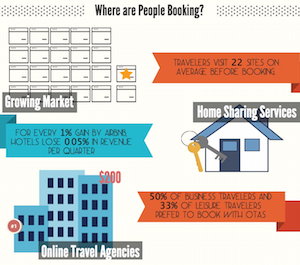
Op-ed: Four tips for hoteliers grappling with data-led decisions
Expedia Group’s Jamie Griego asks "Can you make data-driven decisions at a time where historical trends are irrelevant?"
We’re living in a different world after the past two years, and so much has changed. The concept of ‘revenge travel’ is surging, people are travelling outside peak season, traveller motivations have moved away from price and towards flexibility, accessibility, and sustainability.
As a result, there have been questions around the effectiveness of historical data for informing distribution and revenue management.
Our latest AccomNews print issue is available now! Read it HERE

Recently I had the pleasure of taking part in two revenue and distribution panel events within NoVacancy. And these questions on the data focused around – its relevance, its level of influence and on what to look at and why – were all unpacked by some of our industry’s most esteemed strategic minds.
Prior to Expedia Group, I worked in revenue management and data has always been my main driver. Making decisions that are anchored in evidence has always made sense, and in turn, it drove revenue.
But is ‘historical data’ now irrelevant? My position, and that of the fellow panellists was resounding. Not so much anymore. In fact, ‘data’ is more relevant than ever.
However, as the panel rightly pointed out several times during the discussion – what data set you’re looking at, how frequently you adapt to the data insight and steering far away from a set and forget about a model is crucial.
At Expedia Group, we’ve spent the last few years refining and revolutionising the technology and tools that will support our partners in leveraging our millions of data points for the bespoke benefit of their businesses.
The reality of our recovery is that staff shortages continue to force hotels into the toughest question of all – how can I maximise profit while adjusting occupancy levels so that service levels are not sacrificed?
Understanding your guests’ travel patterns and desires allows you to make informed pricing and staffing decisions. Anticipating on-property spend means that you’ll be able to staff your departments cost effectively so they always meet your guests’ expectations.
So, armed with the added insights of my fellow NoVacancy panellists and expert Account Management team, I’ve pulled out the top four tips to help hoteliers grappling with data-led decision making in this evolved era.
1. Market Segmentation
Dividing the market of potential guests into groups, based on their different characteristics, is a cornerstone of every revenue management strategy. Understanding how your traveller segments behave will allow you to strategically target the right guests for each season and forecast how their stay will impact your hotel’s profitability. Start by considering characteristics such as length of stay, days of week, booking window, cancellation, or no-show rates. Once you know how your guests behave, you can divide them into segments.
2. Demand Forecasting
After you’ve identified your low-yield (lower rate) and high-yield (higher rate) segments, it’s time to think about demand, and how that changes. You want to feel confident that there’s enough high-yield business coming down the pipeline that you can minimise low-yield business – and still sleep at night. That means understanding your constrained demand, unconstrained demand, and adapting to suit. Monitor your strategy against your competitive set. I recommend no more than 5-10 competitors and choosing them against a like criteria such as location, property type, property category and facilities. Use data from all your channels – including your hotel website, OTAs and your channel manager (if you have one). Expedia Group also provides free technology that can help you forecast demand so check to see what’s available.
3. Hotel Performance Metrics
Monitoring your KPIs can also help identify emerging demand trends, opportunities for improvement and areas of success. This area of revenue management is loaded in acronyms so here are the main factors to consider:
- Occupancy rate: the percentage of available rooms that were occupied (sold) during a specified period. While high occupancy is generally desired, a very high occupancy rate might indicate that you are pricing your rooms too low, combined with current staff shortages you may decide to aim for lower occupancy targets with higher-yielding market segments so as not to compromise on guest experience.
- Average Daily Rate: Australia – particularly regional Australia – has been living in quite a high ADR bubble this year, however, as international markets start to rebound, it’s important to monitor all the ebbs and flows of ADR expectations and success.
- RevPAR: calculating RevPAR allows you to evaluate daily performance based on occupancy (how many rooms are sold) and ADR (the average daily rate). RevPAR is a great KPI for helping you quickly assess your financial performance.
- GOPPAR: is gross operating profit per available room. GOPPAR considers revenue and expenses from all areas of the business. That means it’s a good metric for measuring your hotel performance as a whole.
- TRevPAR: TRevPAR is total revenue per available room, it is the overall financial performance of your property because it considers revenue from all departments (RevPAR only considers room revenue performance). TRevPAR is particularly helpful for properties that generate considerable non-room revenue from other services, such as all-inclusive hotels or resorts.
4. Dynamic Pricing
In this post-pandemic world, dynamic pricing was cited by the panellists amongst the most important factors for success. Why?
Because it utilises real-time market demand data instead of historical trends. The mapping of time-based pricing involves changing room rates daily, or multiple times during the day based on the data. A few areas to avoid in dynamic pricing include accepting reservation too early, pricing by intuition instead of based on the hard data in front of you, limiting pricing decisions to business hours, and reacting suddenly to individual competitor prices instead of the competitor set as a whole.
Connecting with guests, helping them enjoy extraordinary experiences and create lasting memories is at the core of why we work in hospitality.
However, at a time where resources are stretched, and revenue managers feel like they are often flying blind, technology can be the solution that increases the effectiveness and efficiencies across your revenue management strategy.
Data-led decisions support a strategy that reflects your unique market, guests and property, and will give you a strong, lasting foundation for maximising income.
This is the insight that Expedia Group Partner Central platform exists to provide – leveraging our millions and millions of data points to help a hotel create its own bespoke one-in-a-million-revenue management strategy.
From crafting a custom competitive set to leveraging real-time public market data to understand the current state of occupancy and ADR; there is world-leading insight available to support data-led decisions that are more relevant during recovery than running business as usual. I’d invite any partners looking to improve their bottom lines across the rebuild period to explore the suite of free revenue management tools available in Expedia Group’s Partner Central.
Jamie Griego is Expedia Group’s Director, Account Management (Australia).
Jamie Griego is Director, Market Management, Australia for Expedia Group.






